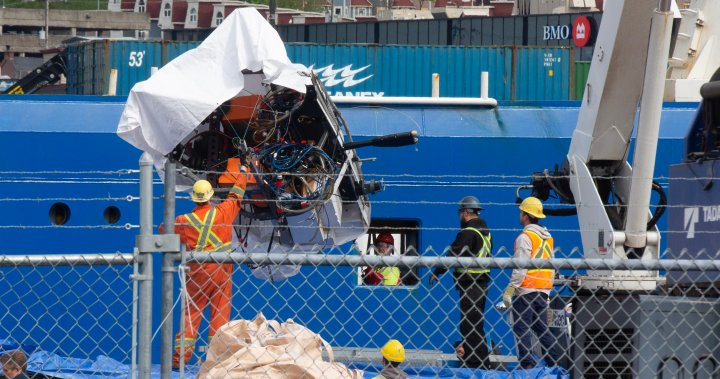Canada
Eerie new audio released, believed to be the moment the Titan sub imploded

The Chilling Audio: Unveiling the Final Moments of the Titan Submersible
Tragedy Strikes in the Depths: The Titan Submersible Disaster
On June 18, 2023, the world witnessed a devastating tragedy when the Titan submersible imploded during an expedition to the Titanic wreckage, claiming the lives of all five people on board. The submersible, operated by OceanGate, was on a tourist expedition to explore the historic Titanic site when catastrophe struck. The incident has left the world in shock, raising critical questions about safety, design flaws, and the risks associated with deep-sea exploration.
A Chilling Audio: The Exact Moment of the Implosion
In a harrowing development, the U.S. Coast Guard released a 20-second audio clip on February 7, 2025, captured by a National Oceanic and Atmospheric Administration (NOAA) device approximately 1,400 kilometers from the submersible’s last known location. The audio, described as a "suspected acoustic signature," captures a loud bang followed by an ominous whooshing noise and an eerie silence. Researchers believe this audio marks the exact moment the Titan submersible imploded, ending the lives of its crew and passengers instantly.
The clip provides a haunting glimpse into the final moments of the doomed vessel. The submersible had been on a dive to the Titanic wreckage, located off the south coast of Newfoundland, when it lost contact with its support ship, the Polar Prince. The wreckage was later discovered just 300 meters from the Titanic’s bow, a poignant reminder of the tragedy.
Final Communications and Desperate Search
The Titan submersible lost contact with the Polar Prince over an hour into its dive. The final messages exchanged between the crew and the support staff revealed no signs of distress. "All good here," read one of the last communications, suggesting that the crew was unaware of the impending disaster. The search for the submersible was desperate and extensive, involving multiple agencies. Four days later, the wreckage was finally located, bringing closure to the families of the victims but also raising questions about the cause of the tragedy.
Among the victims were Paul-Henri Nargeolet, a renowned Titanic expert and deep-sea explorer who served as the sub’s co-pilot; Stockton Rush, the CEO of OceanGate; Shahzada Dawood and his 19-year-old son Suleman Dawood, members of a prominent Pakistani business family; and Hamish Harding, a British adventurer and entrepreneur. Their deaths have left a profound impact on their loved ones and the broader community of explorers and scientists.
Unveiling the Flaws: Investigation Finds Critical Design Issues
The investigation into the Titan submersible tragedy has revealed disturbing details about the vessel’s design and safety. Engineers from the National Transportation Safety Board (NTSB) testified that the submersible’s carbon fibre hull had imperfections, including wrinkles, porosity, and voids, which were present since its manufacturing. These flaws likely weakened the structure over time, especially given the extreme depths the Titan was designed to reach.
Don Kramer, an NTSB engineer, revealed that the hull pieces recovered from the seafloor showed significant delamination of the carbon fibre layers, a critical failure that would have led to the implosion. The use of carbon fibre, an unconventional and unreliable material for deep-sea submersibles, has come under intense scrutiny. Each dive likely caused further damage to the vessel, making it increasingly susceptible to failure.
In a chilling revelation, the Titan’s window was rated for a depth of only 1,300 meters, far shallower than the nearly 4,000 meters it was attempting to reach. William Kohnen, a submersibles expert, testified that he and other industry professionals had warned OceanGate about these dangers as early as 2018. Kohnen, who helped design the Titan’s window, had recommended an arched acrylic design for structural integrity but was overruled by the company.
A Preventable Disaster: Expert Warnings and Industry Concerns
The tragedy has been described as preventable by experts like Kohnen, who expressed frustration over the lack of scrutiny and oversight in the submersible’s design and operation. "I don’t think many people ever told Stockton no," Kohnen remarked, highlighting OceanGate CEO Stockton Rush’s resistance to outside criticism and industry standards.
Kohnen and others had raised concerns about the Titan’s experimental design, insufficient testing, and the risks of using unconventional materials. Despite these warnings, the Titan continued to operate, taking tourists to the Titanic wreckage since 2021. The 2023 disaster has exposed a culture of complacency and a prioritization of ambition over safety.
The Coast Guard’s Ongoing Investigation and the Road Ahead
The U.S. Coast Guard is expected to release a final report on the Titan submersible tragedy in the coming months. The investigation has already shed light on critical flaws in the vessel’s design, material choices, and operational practices. The findings are expected to have far-reaching implications for the deep-sea exploration industry, prompting calls for stricter regulations and better safety protocols.
As the world grapples with the lessons of this tragedy, the families of the victims continue to mourn their loved ones. The Titan submersible disaster serves as a stark reminder of the risks and challenges of exploring the deep ocean and the importance of prioritizing safety above all else. The release of the chilling audio has brought the tragedy into sharp focus, leaving many to reflect on the human cost of pushing the boundaries of human knowledge and exploration.
In the aftermath of this devastating event, the deep-sea exploration community must confront hard questions about innovation, accountability, and the ethical responsibilities that come with venturing into the unknown. The Titan submersible tragedy will forever be remembered as a cautionary tale about the dangers of neglecting safety in pursuit of discovery.